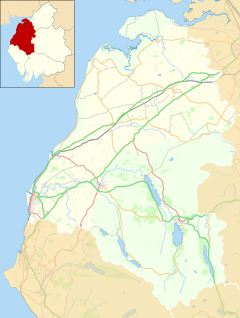| Papcastle | |
|---|---|
 Papcastle House | |
| Population | 385 (2011) [1] |
| OS grid reference | NY109315 |
| Civil parish |
|
| Unitary authority | |
| Ceremonial county | |
| Region | |
| Country | England |
| Sovereign state | United Kingdom |
| Post town | COCKERMOUTH |
| Postcode district | CA13 |
| Dialling code | 01900 |
| Police | Cumbria |
| Fire | Cumbria |
| Ambulance | North West |
| UK Parliament | |
Papcastle is a village and civil parish in the district of Cumberland in the English county of Cumbria. The village is now effectively a northern extension of Cockermouth, which lies to the south of the River Derwent. It has its own parish council and lies within Bridekirk Parish for Church of England purposes. In 2001 it had a population of 406, [2] reducing to 385 at the 2011 Census.
Contents
The name of Papcastle is said to be a compound formed from Old Norse and Old English papi+cæster, meaning 'the Roman fort inhabited by a hermit'. [3]

